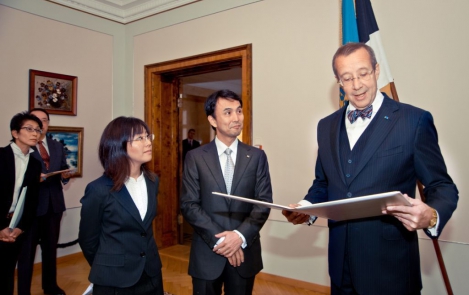-
Reset
+


Estonian Head of State receives the representatives of the Stone for Peace Association of Hiroshima
21.10.2011
President Toomas Hendrik Ilves met today with the leaders of the Stone for Peace Association of Hiroshima, Michio Umemoto and Yoji Okamoto, who placed a memorial stone in the Japanese garden in Kadriorg, in remembrance of the Hiroshima nuclear bomb blast on 6 August 1945.
This granite slab is one of the streetcar track pavement stones from the Bridge of Aioi, Hiroshima, which was a couple of hundred metres from the epicentre of the blast.
“We are donating these memorial stones to nations all over the world in the hope that the whole of mankind will wish – as we wish – for a world without wars and will protect this stone, which has witnessed the nuclear blast in Hiroshima, to remind us all about how important peace is,” is written onto the plaque, which was handed over to the Estonian Head of State today along with the memorial stone.
According to President Ilves, Estonia and Japan are linked by their wish to live in peace, as well as the wish for a safer world, and we are both contributing to this in our own way.
“The Japanese people are aware of the price of peace, based on their own historical experiences, and this is also well acknowledged in Estonia, which has also experienced suffering caused by war. We were both severely scarred by World War II,” President Ilves said. He confirmed that Estonia is looking forward to closer relations with Japan, as: “We have more in common than first meets the eye.”
The Stone for Peace Association of Hiroshima was established in 1991. It is a non-profit organisation, which donates street pavement slabs to nations all over the world; the slabs are engraved with an image of the Goddess of Mercy and were removed from the epicentre of the nuclear blast that took place on 6 August 1945 in Hiroshima. The stone for peace is there to remind people of the Hiroshima tragedy and express the desire of people for peace. Today, stones for peace have been donated to the representatives of more than 100 countries; they have been accepted by numerous European leaders – including leaders from the Czech Republic, Germany, Iceland, the United Kingdom, Finland, Ireland, Norway, Latvia and Lithuania, Pope John Paul II, and more.
The stone for peace that was presented to Estonia was placed in the recently completed Japanese garden in Kadriorg Park.
Office of the President
Public Relations Department
Phone 631 6229




